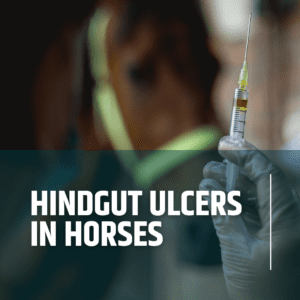
By Ben Nedas
Chief Commercial Officer
The Role of the Hindgut in Equine Digestion: A Comprehensive Overview
01
Introduction
The digestive system of horses is a biological engineering marvel. It is an intricate and complex network made to draw nutrients from a diet primarily made up of forage. The hindgut is one of the many parts that make up this system, and it stands out because of the important role it plays in the digestion and absorption of nutrients, particularly fibre. It is critical for the health and well-being of our equine companions that we have a solid understanding of the role that the hindgut plays in the digestive process.
In this article, we will examine the anatomy of the hindgut, as well as its function and the role it plays in the digestive process of horses.
02
Anatomy of the Hindgut
About 65% of a horse's digestive power comes from the hindgut, which is made up of the cecum, the large colon, the small colon, and the rectum. It begins with the cecum, a large, blind-ended pouch located at the junction of the small and large intestines. The cecum is frequently referred to as the 'fermentation vat,' owing to its primary function in the digestive process. It is here that the majority of fibre fermentation occurs.
Following the cecum is the large colon, the most voluminous part of the horse's digestive tract. It is intricately folded and has a complex structure, which allows it to maximise its function in the digestive process. The small colon follows, which, despite its name, is quite significant in the final stages of digestion. The rectum is the final part of the hindgut, serving as a reservoir for faeces before expulsion.
03
Function of the Hindgut
The primary role of the hindgut is the digestion and absorption of nutrients, particularly fibre.
The cecum houses a vast population of microbes that break down complex carbohydrates, such as cellulose and hemicellulose, into volatile fatty acids (VFAs). These VFAs—acetate, propionate, and butyrate—are a significant source of energy for the horse.
The large colon plays a dual role in the digestive process. It is the primary site for water and electrolyte absorption, which is crucial for maintaining the horse's hydration and electrolyte balance. It also plays a role in further fermentation of fibre, extracting additional nutrients and energy from the feed.
The small colon is where the formation of faecal balls occurs. This process involves the absorption of water and the mixing of the remaining material, which is then formed into faecal balls for expulsion.
04
Microbial Inhabitants and their Role
The hindgut is home to a diverse community of bacteria, protozoa, and fungi, collectively known as the microbiota. These microbes are responsible for the fermentation process that breaks down complex carbohydrates into digestible VFAs. They also synthesise certain vitamins, such as vitamin K and B-vitamins, contributing to the horse's nutritional needs.
The balance of this microbial population is crucial for optimal hindgut function. Disruptions, often caused by sudden changes in diet, can lead to digestive disorders like colic or laminitis. Therefore, maintaining a consistent and balanced diet is key to preserving the health of the hindgut microbiota.
05
The Importance of Fibre
Horses are designed to consume a diet rich in fibre, primarily from grasses and hay. The hindgut's ability to ferment these fibre allows horses to extract energy from sources that would otherwise be indigestible. This capability is particularly important for horses on forage-based diets, where the energy derived from VFAs can account for up to 70% of their total energy requirement.
06
Hindgut Health and Maintenance
Maintaining hindgut health is paramount for a horse's overall wellbeing. A balanced, fibre-rich diet is key, along with gradual changes to avoid upsetting the microbial balance. Regular exercise, access to clean water, and routine veterinary check-ups also contribute to a healthy hindgut.
This extensive system allows for the slow and steady digestion of fibrous feeds, maximising nutrient extraction and absorption. However, its complexity and length also make it susceptible to various health issues, such as impactions and twists. Therefore, careful management of diet and regular health checks are crucial.
In addition, digestive enzymes, prebiotics and probiotics are used with the intention of supporting a healthy hindgut. Check out our article: Supporting a horse’s gut microbiome with supplements: which option is right for your horse?
07
Conclusion
In conclusion, the hindgut plays a pivotal role in equine digestion. It not only allows horses to utilise energy from fibrous feeds but also contributes to water and electrolyte balance and vitamin synthesis. A greater understanding of the hindgut's function and the factors affecting its health can help us better care for our horses, ensuring they lead healthier, happier lives. By paying attention to the diet, ensuring regular exercise, and providing routine health checks, we can help maintain the health of the hindgut and, by extension, the overall health of the horse.
ABOUT EQUINECTAR
Description
EquiNectar® is a natural feed supplement, that is scientifically proven to:
- Re-balance your horse’s gut bacteria
- Help your horse maximise benefits from its feed
- Improve your horse’s condition
More information
EquiNectar® is produced by Tharos Ltd in the UK. It is a natural source of digestive enzymes and contains only the following ingredients:
- Our patented enzyme rich malt extract
- Medium chain triglycerides (from coconut oil)
- Potassium sorbate
For more details of the enzymes within EquiNectar® take a look at the ingredients and enzymes page.
How to feed
Simply add EquiNectar® to your horse's daily feed, using the Feeding Rate chart to determine the correct amount.
For detailed instructions about how to introduce EquiNectar, please read the comprehensive Feeding Guide page.





